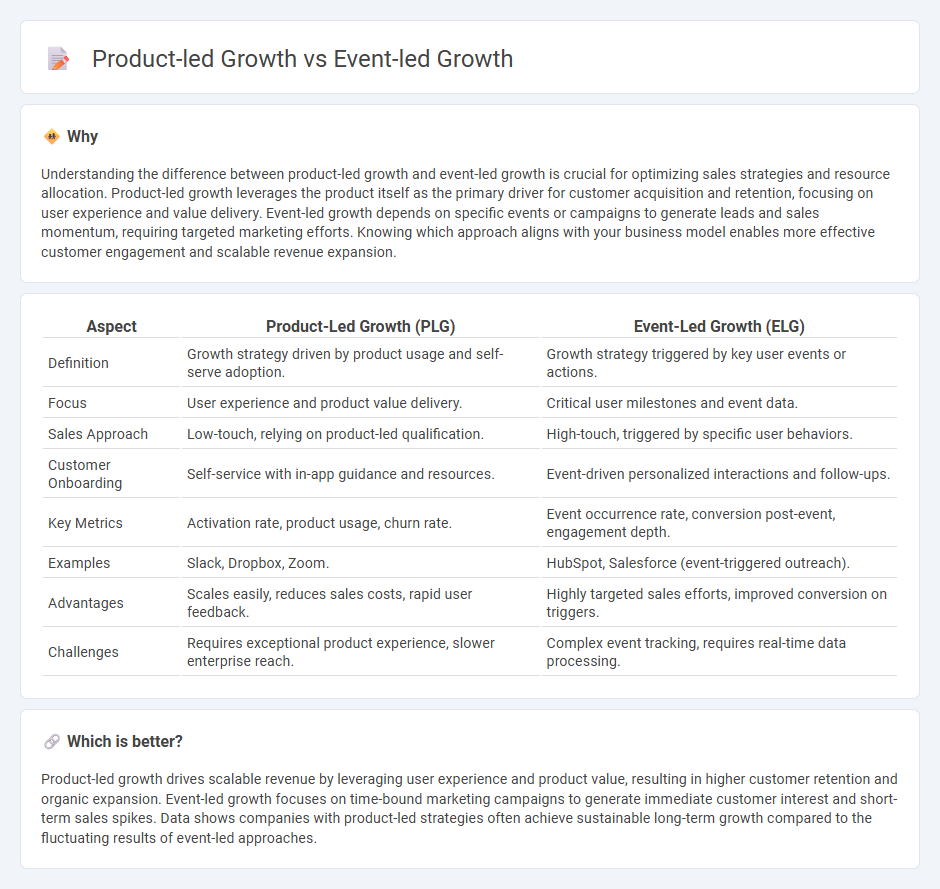
Product-led growth focuses on using the product itself as the primary driver of customer acquisition, engagement, and retention by delivering exceptional user experiences and value. Event-led growth relies on specific marketing or sales events such as webinars, conferences, or product launches to generate leads and accelerate sales cycles. Explore how these strategies can be tailored to boost your company's revenue and market presence.
Why it is important
Understanding the difference between product-led growth and event-led growth is crucial for optimizing sales strategies and resource allocation. Product-led growth leverages the product itself as the primary driver for customer acquisition and retention, focusing on user experience and value delivery. Event-led growth depends on specific events or campaigns to generate leads and sales momentum, requiring targeted marketing efforts. Knowing which approach aligns with your business model enables more effective customer engagement and scalable revenue expansion.
Comparison Table
| Aspect | Product-Led Growth (PLG) | Event-Led Growth (ELG) |
|---|---|---|
| Definition | Growth strategy driven by product usage and self-serve adoption. | Growth strategy triggered by key user events or actions. |
| Focus | User experience and product value delivery. | Critical user milestones and event data. |
| Sales Approach | Low-touch, relying on product-led qualification. | High-touch, triggered by specific user behaviors. |
| Customer Onboarding | Self-service with in-app guidance and resources. | Event-driven personalized interactions and follow-ups. |
| Key Metrics | Activation rate, product usage, churn rate. | Event occurrence rate, conversion post-event, engagement depth. |
| Examples | Slack, Dropbox, Zoom. | HubSpot, Salesforce (event-triggered outreach). |
| Advantages | Scales easily, reduces sales costs, rapid user feedback. | Highly targeted sales efforts, improved conversion on triggers. |
| Challenges | Requires exceptional product experience, slower enterprise reach. | Complex event tracking, requires real-time data processing. |
Which is better?
Product-led growth drives scalable revenue by leveraging user experience and product value, resulting in higher customer retention and organic expansion. Event-led growth focuses on time-bound marketing campaigns to generate immediate customer interest and short-term sales spikes. Data shows companies with product-led strategies often achieve sustainable long-term growth compared to the fluctuating results of event-led approaches.
Connection
Product-led growth leverages the product as the primary driver for customer acquisition, engagement, and retention by offering value through user experience and features. Event-led growth complements this by using targeted events such as webinars, product launches, or demos to create awareness, generate leads, and accelerate product adoption. Together, these strategies create a seamless sales funnel where product experiences fuel interest and events drive deeper engagement and conversions.
Key Terms
Lead Generation
Event-led growth leverages live or virtual events to engage potential customers, creating high-quality lead generation opportunities through direct interaction and personalized experiences. Product-led growth relies on the product itself to drive user acquisition and leads, using features like freemium models or trial periods to attract and convert users organically. Explore detailed strategies to optimize lead generation with event-led and product-led growth approaches.
User Onboarding
Event-led growth leverages targeted, real-time events to drive user engagement and accelerate onboarding by creating personalized experiences, while product-led growth emphasizes a seamless, intuitive product interface that naturally guides users through value discovery. User onboarding in event-led growth often involves dynamic triggers such as webinars, live demos, and interactive tutorials to boost activation rates. Explore how integrating event-driven strategies can complement product-led approaches to optimize user onboarding and growth.
Conversion Funnel
Event-led growth centers on leveraging live experiences to drive user engagement and accelerate movement through the conversion funnel, emphasizing real-time interactions and personalized touchpoints. Product-led growth relies on the product itself as the primary driver to attract, engage, and convert users by optimizing product features and user experience within the funnel stages. Explore how integrating these growth strategies can maximize conversion efficiency and revenue potential.
Source and External Links
Event-led Growth 101: What Does It Do? | EventX Blog - Event-led growth is the strategic use of events like conferences and product launches to attract new customers, generate leads, and create brand awareness by delivering memorable and engaging experiences that drive business growth.
New Report Reveals Events are Mission-Critical for Business Growth - Event-led growth strategies are used by 67% of teams, with adopters being 140% more likely to achieve over 50% company growth, highlighting events as a vital, programmatic marketing channel for pipeline and revenue growth in 2025.
The Rise of Event-Led Growth | Splash - Event-led growth is a go-to-market approach leveraging events as the main channel for customer acquisition and retention, with 93% of companies using ELG achieving their revenue or pipeline goals through scalable and measurable event programs.
 dowidth.com
dowidth.com